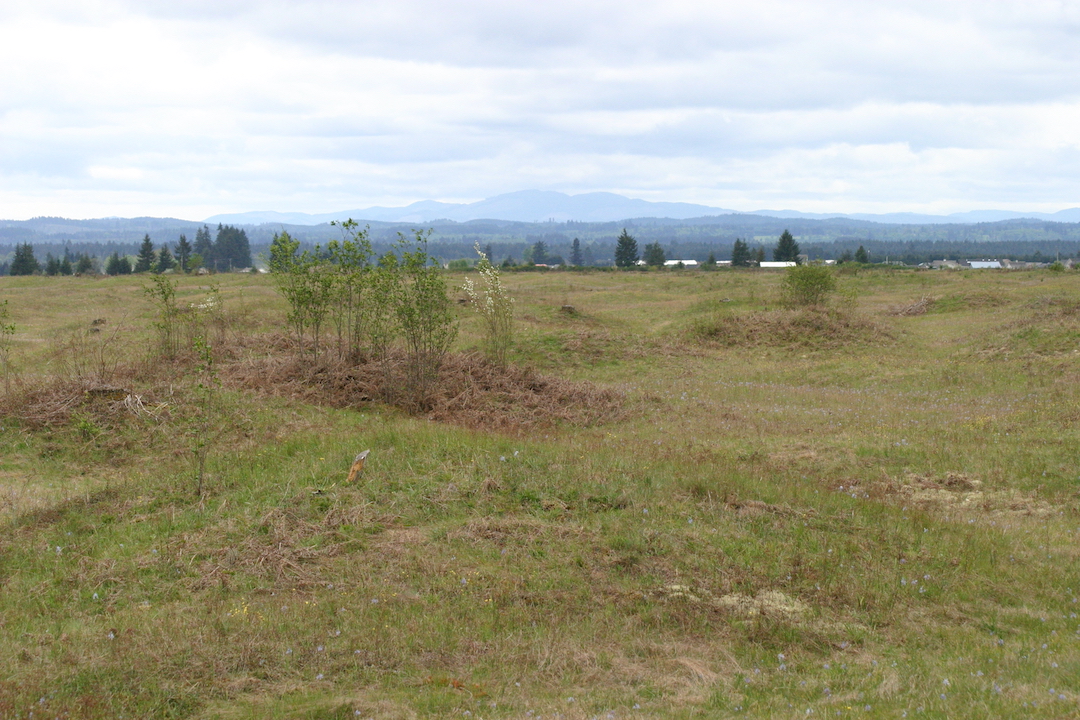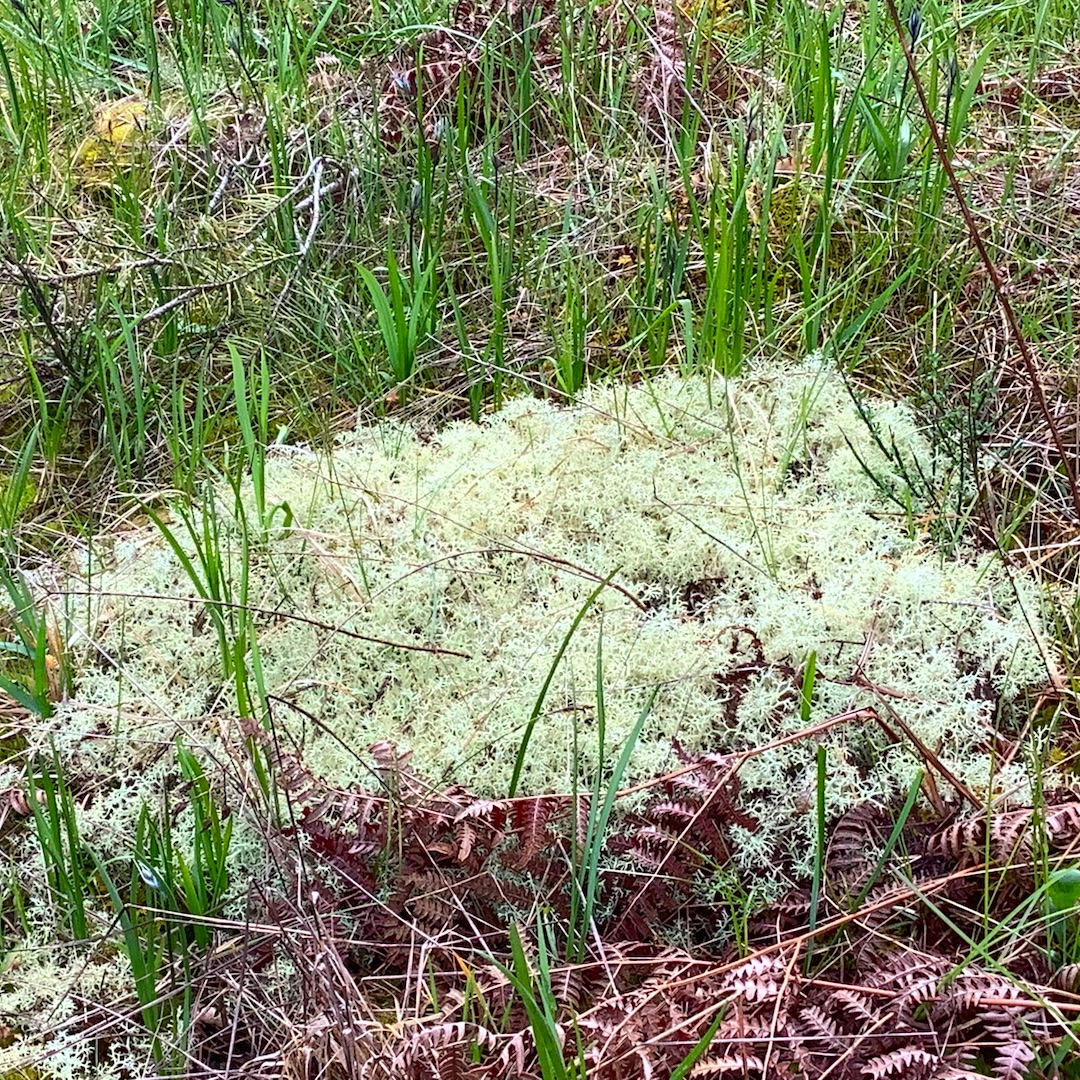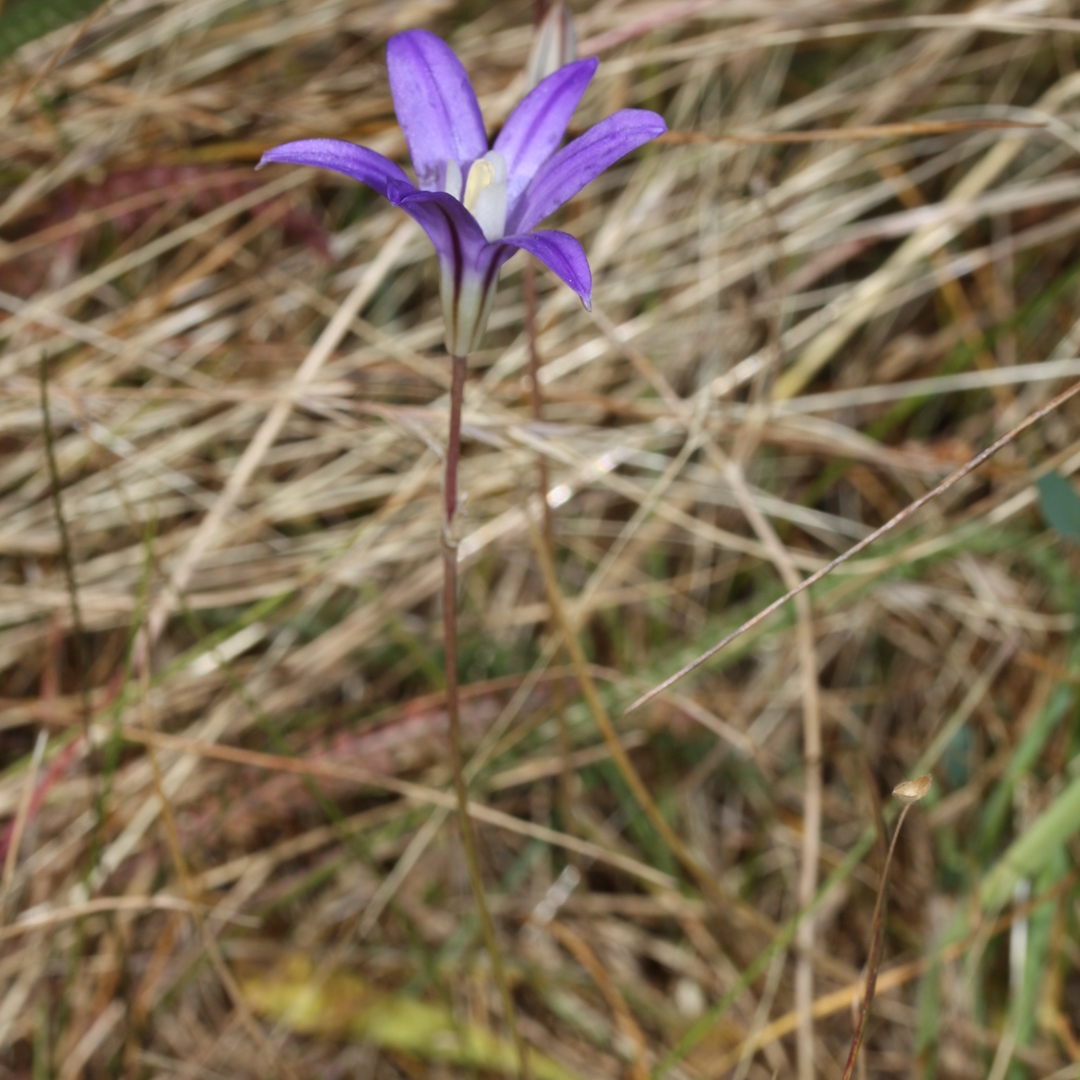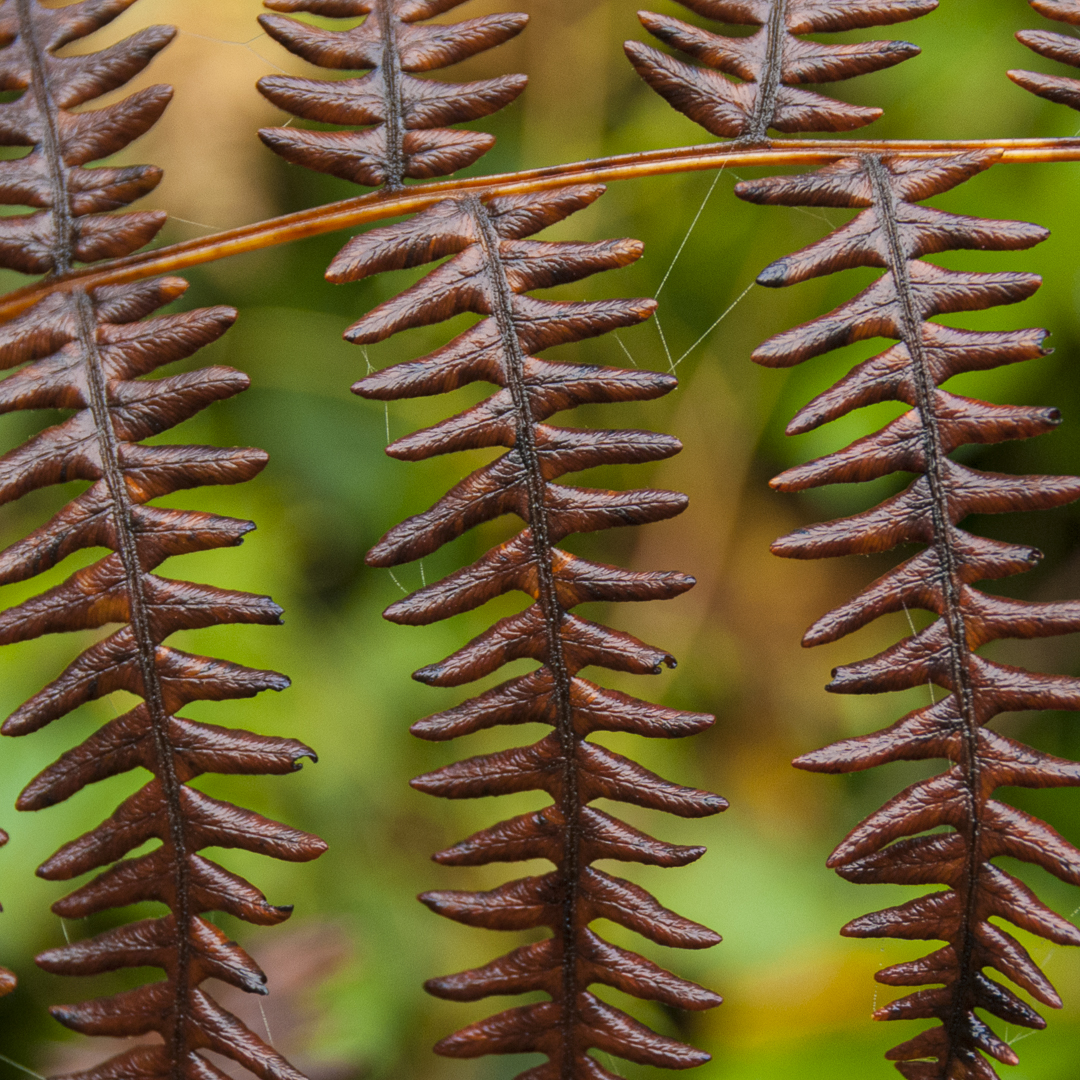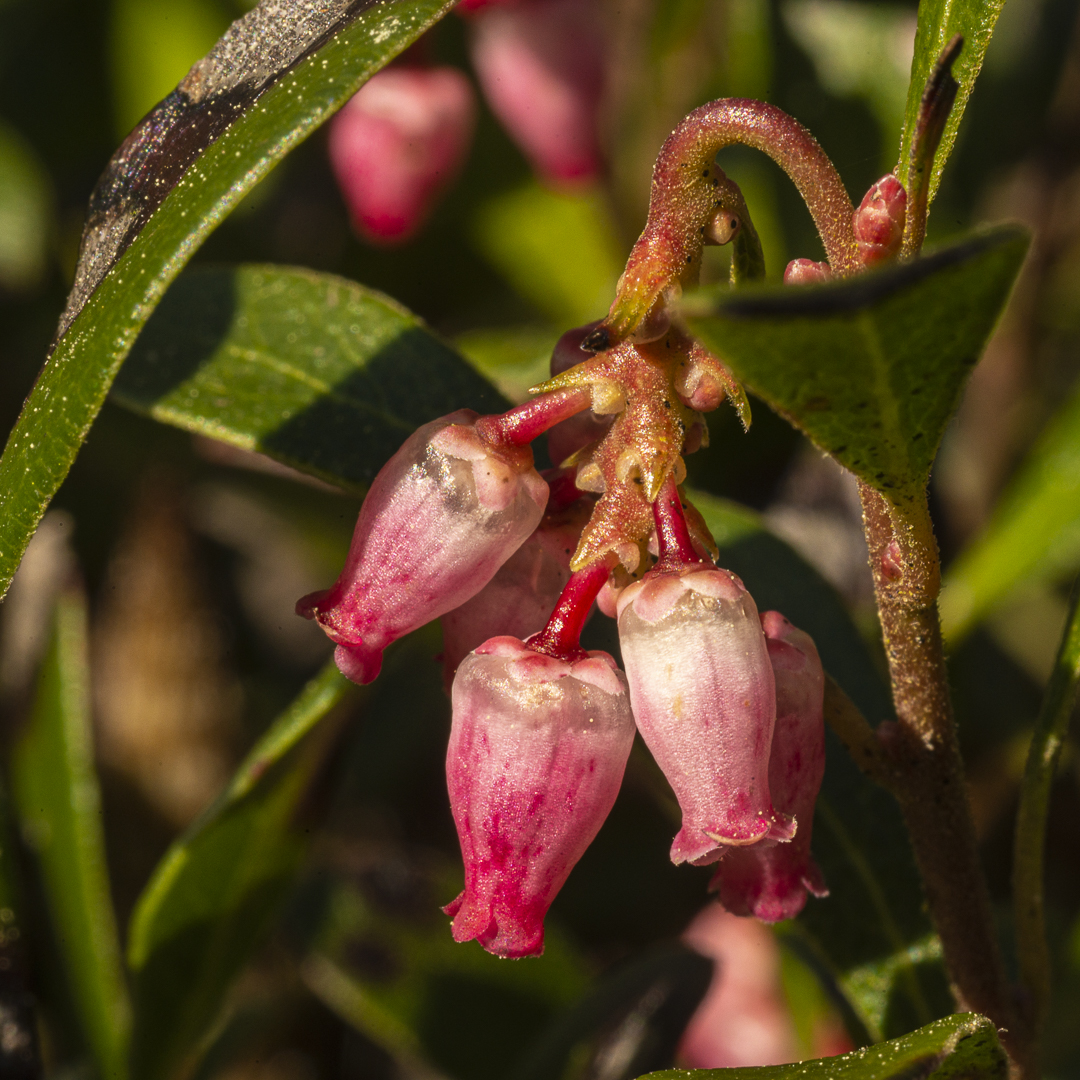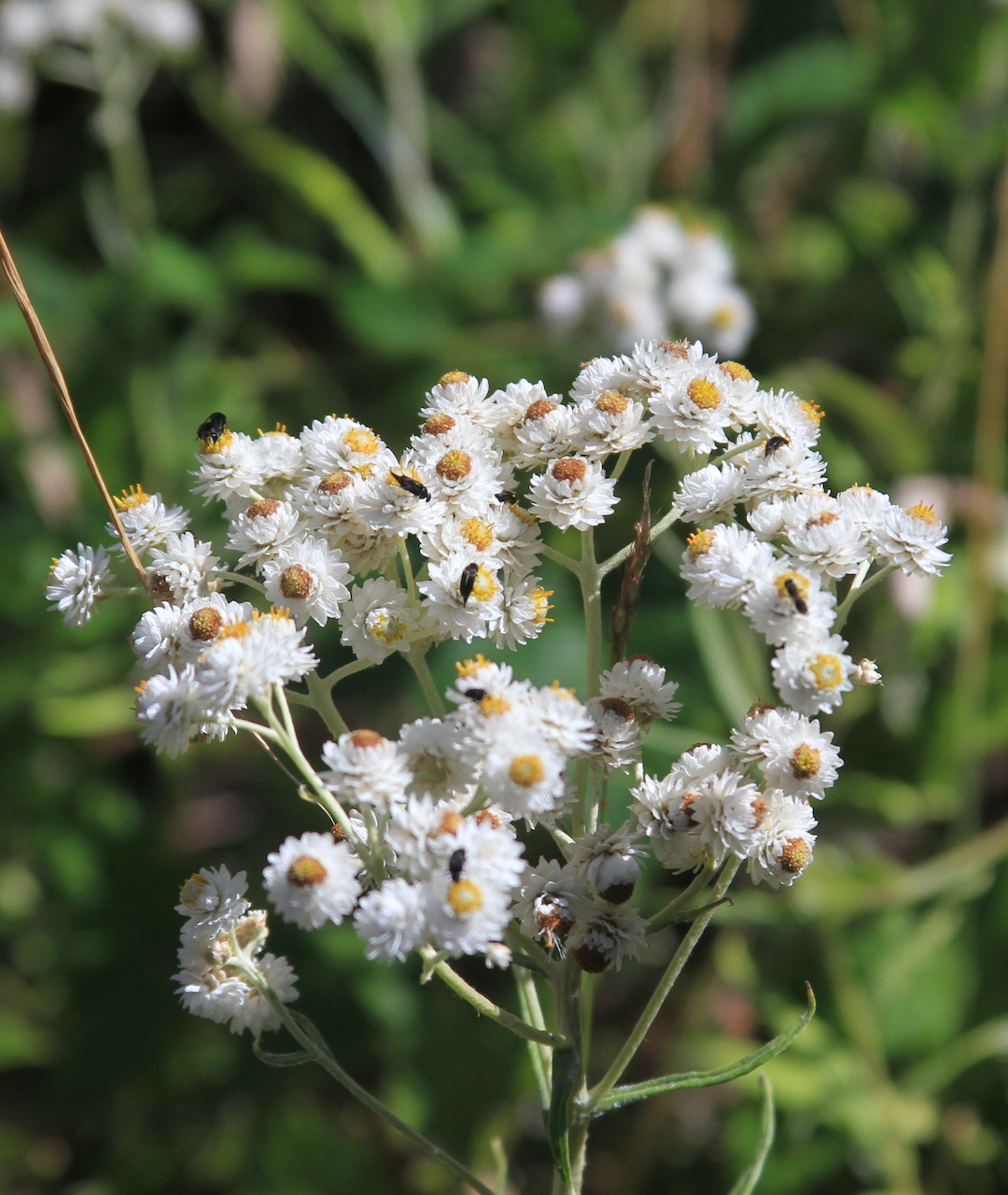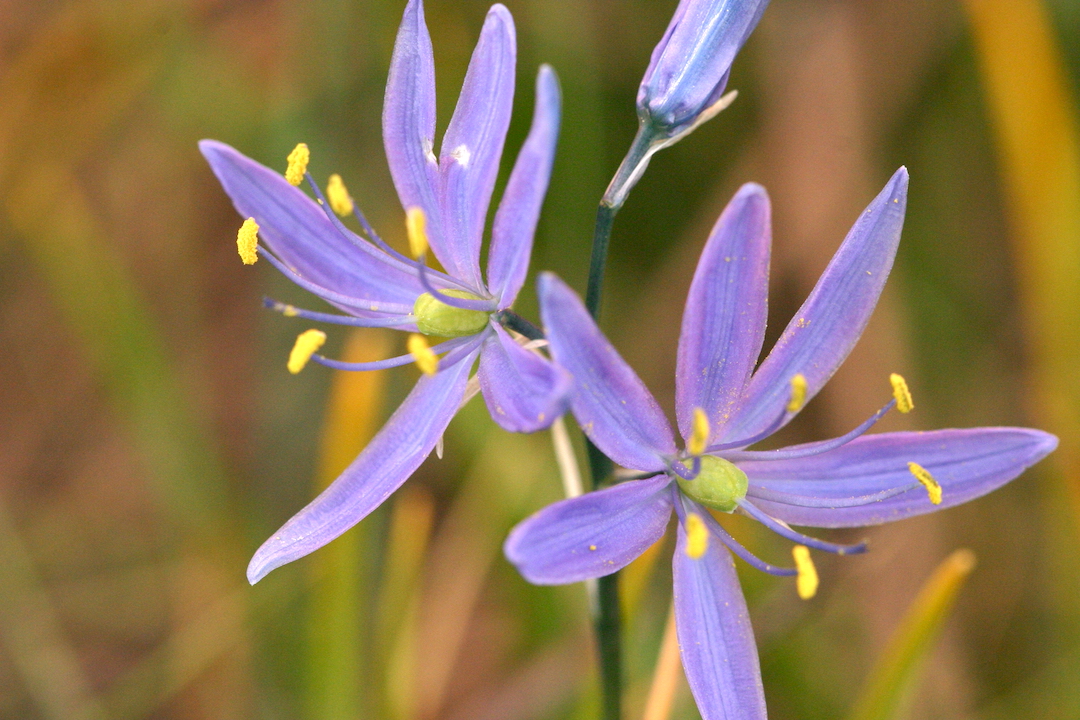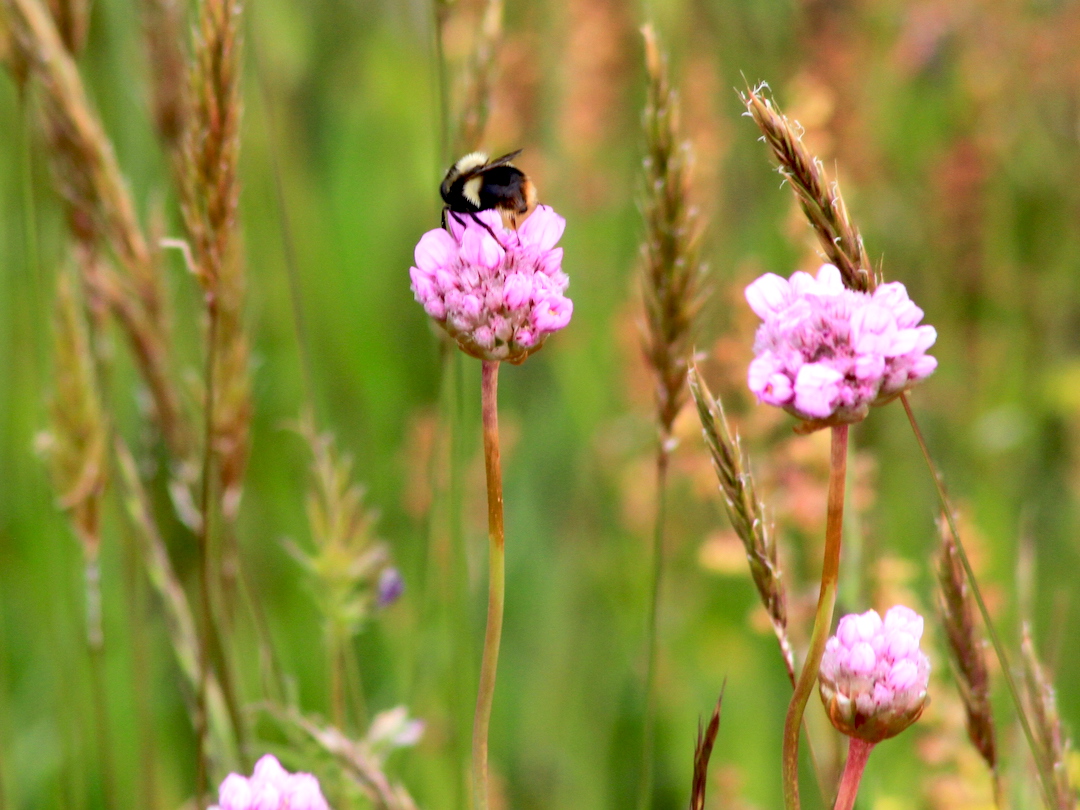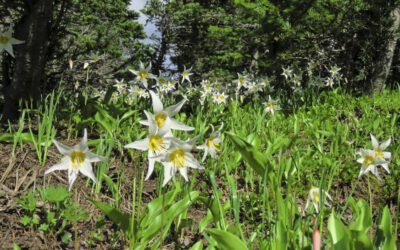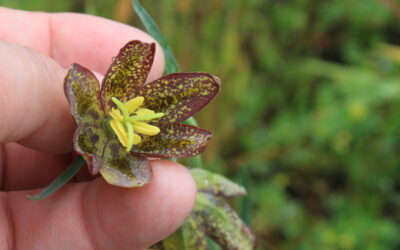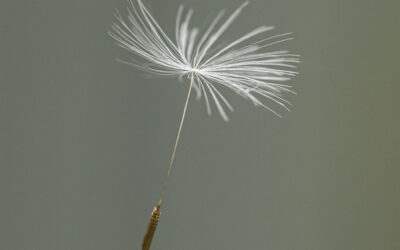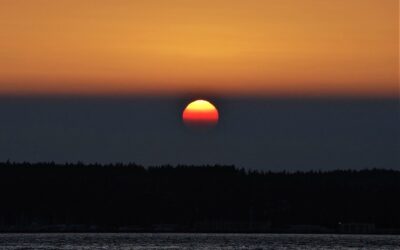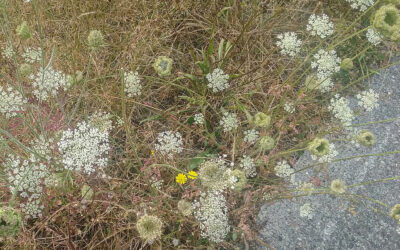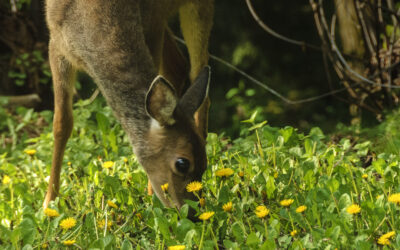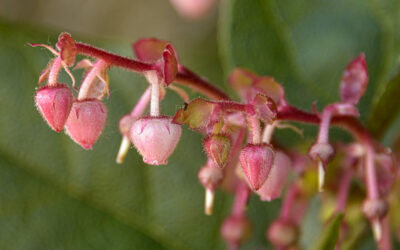AFTER THE CAMAS:
Summer in the Puget Sound PrairieBy Katherine Derbyshire, Autumn 2022
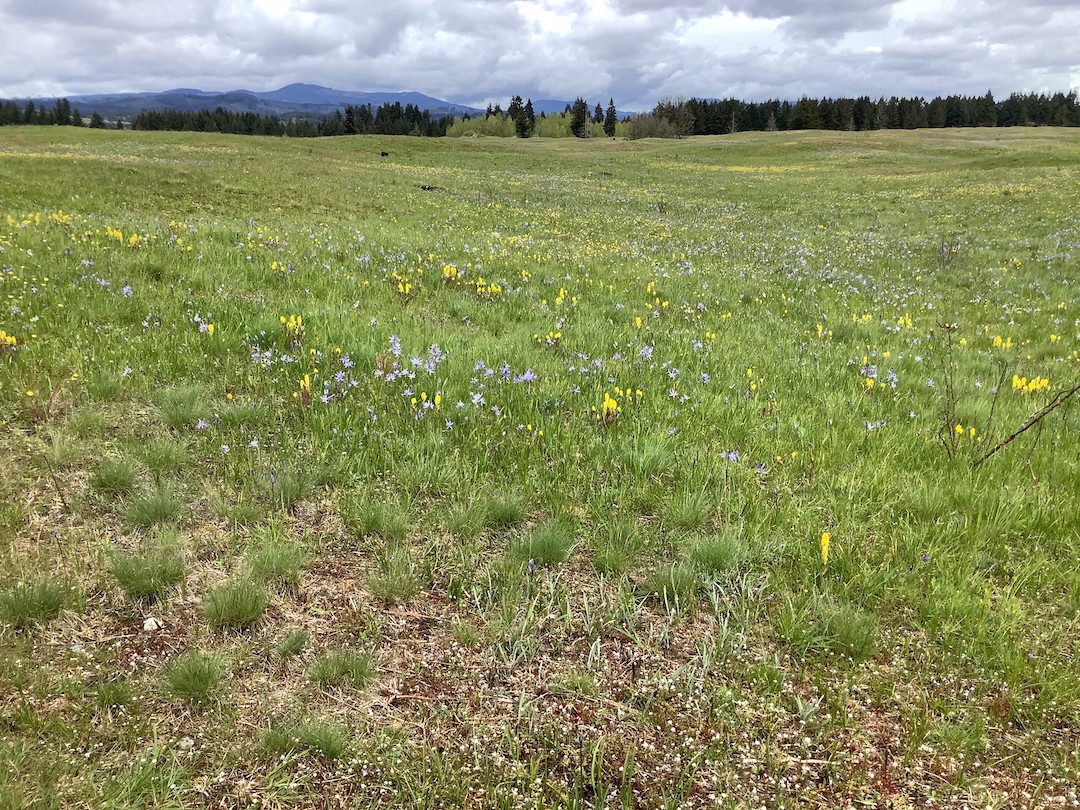
Spring bloom on the prairie at Glacial Heritage Preserve near Grand Mound, Washington. photo by Thomas Noland
AFTER THE CAMAS:
Summer in the Puget Sound PrairieBy Katherine Derbyshire, Autumn 2022
Editor’s Note: Mima Mounds near Littlerock, Washington, is one of several prairie landscapes in the Salish Sea region. As described in a previous article, Bringing Back the Riches of the Prairies, a unique community of plant species inhabits the gravelly soils deposited by glaciers during the last ice age. During early spring, prairies are carpeted in wildflowers. What happens on the prairie later in the year, when the spring beauties have gone to seed?
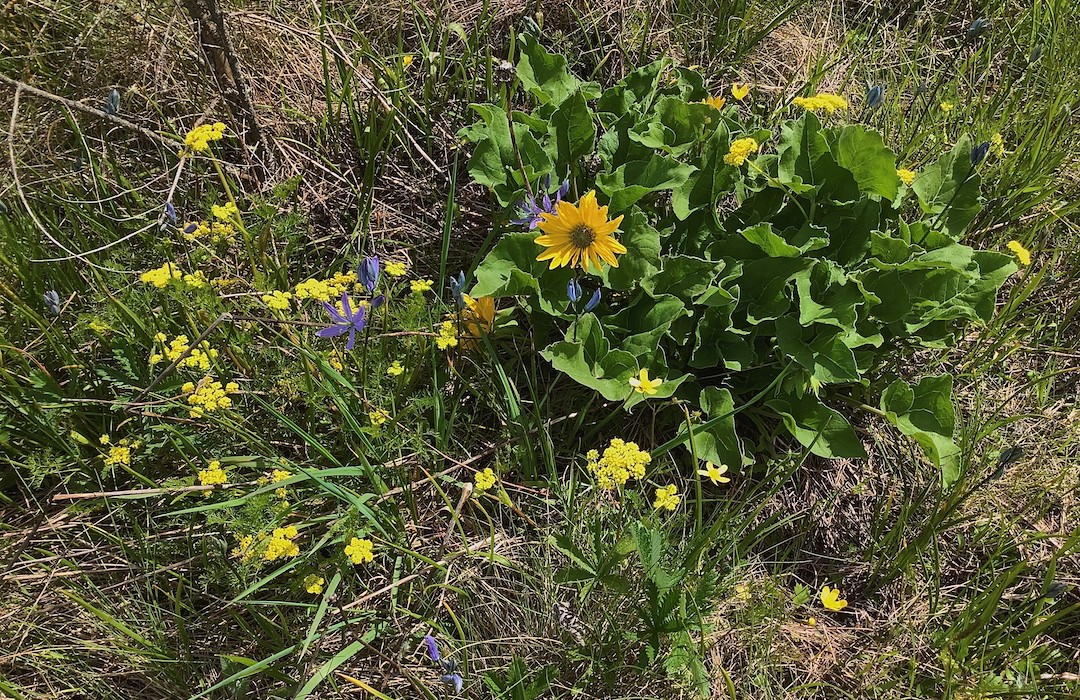
A spring prairie bouquet of desert parsley (yellow flowers at left), common camas, and balsamroot (large yellow flowers at right). photo by Thomas Noland
The Mima Mounds Natural Area Preserve looks very different in August than in May. In May, a carpet of blue camas and yellow desert parsley shimmers in the sun. The grass is green and lush; small trees here and there show off their new leaves.
In August, non-native plants dominate the prairie landscape. Plump brown seed heads wave on invasive oat grass stalks. The Scotch broom is still green after weeks of dry weather, but that’s not good news. Scotch broom changes the soil chemistry, making the soil less suitable for some native plants. “Non-natives” are not always bad, though, as Washington Department of Natural Resources ecologist David Wilderman explained.
Harvest brodiaea. photo by Walter Siegmund, Creative Commons. License at Creative Commons Legal Code
If you walk through the Preserve with Wilderman in August, he’ll show you where native species are thriving. Here, there’s a thick carpet of reindeer lichen. There, clusters of harvest brodiaea. The cooler and wetter north sides of the mounds are dense with western bracken ferns. Tiny red berries are just starting to appear in patches of kinnikinnick. Native Roemer’s fescue and invasive grasses grow side by side.
where is the summer nectar?
What you won’t see in late summer, though, are large numbers of nectar-bearing flowers. In spring, mild weather and reliable moisture encourage both nectar-bearing plants and the insects that depend on them. Later in the summer, warmer and drier weather leaves emerging insects with fewer choices. Native plants like spreading dogbane and pearly everlasting are rare or entirely absent. Non-native plants like tansy ragwort, a European weed that’s toxic to livestock, can be important food sources for pollinating insects.
It’s not clear whether the limited availability of summer nectar sources is natural or a symptom of the degraded state of most Puget Sound prairies. Has this ecosystem niche always been relatively empty? The question requires further investigation. For rare summer butterflies like the valley silverspot and the Puget Sound fritillary, it’s a matter of survival.
Herbarium collections suggest that the prairies were once more diverse. Susan Waters, founder and senior research ecologist at Quamash EcoResearch, cautioned that those collections aren’t necessarily representative, though. Collectors often focus on plants that are showy or unusual in some way. Common plants, because they are common, are less noteworthy and less likely to appear in collections.
Moreover, herbarium collections cover a limited time period, only back to the late 1800s in Washington state. The Puget Sound prairies first appeared around 16,500 years ago. As glaciers receded, they left well-drained, gravelly, nutrient-poor soil. Very different from the rich mix of clay and organic material found in wet lowland meadows, these “prairie” soils support their own unique and diverse ecosystem.
Before Europeans arrived, native peoples harvested camas, bracken, and other plants. Fire, both natural and human-controlled, limited intrusions by grasses and young trees. Without these interventions, Wilderman said, the Mima Mounds prairie would eventually be overwhelmed by woodland species like the Garry oaks and Douglas firs along the edge of the Preserve.
how does restoration help the prairie?
We don’t know what species were present in pre-settlement prairies, but we do have reference sites that have been either preserved intact or have been under restoration for fifteen years or more. Waters compared these sites to more recent prairie restorations and found an explosion of previously unrecognized diversity in both plant and pollinator species.
How do plant-pollinator communities respond to restoration?
Pollinators like bumblebees visit flowers where they can find them among the grasses on summer prairies. photo by Thomas Noland
When observed in a degraded ecosystem, Waters said, most native pollinators appear to be generalists, able to thrive on a wide variety of both native and non-native plants. As restoration efforts diversify the available plant species, pollinators appear to become more selective, limiting themselves to a short list of preferred plants. Having a diverse food supply makes pollinators more resilient if their preferred food is unavailable, while specialization may offer a diet that better matches the specific insect’s needs. Plants, meanwhile, benefit from pollinator specialization. If a pollinator visits plant A more often, then each visit is more likely to transfer type A pollen. More efficient pollination increases the likelihood of successful seed setting and further propagation.
what about climate change?
Neither Waters nor Wilderman was willing to predict the impact of climate change on Puget Sound prairies. Warmer and drier summers are likely to challenge native plants accustomed to milder conditions. Different plants have different requirements, though, so not all will respond to climate change in the same way. Some plants may bloom later or earlier, some for longer or shorter periods. The overlap between flower emergence and the emergence of pollinator species may change. Will insect populations be decimated if their preferred food is unavailable? Or will non-native invaders help fill gaps in the insect food supply? Waters’s research suggests that both outcomes are possible.
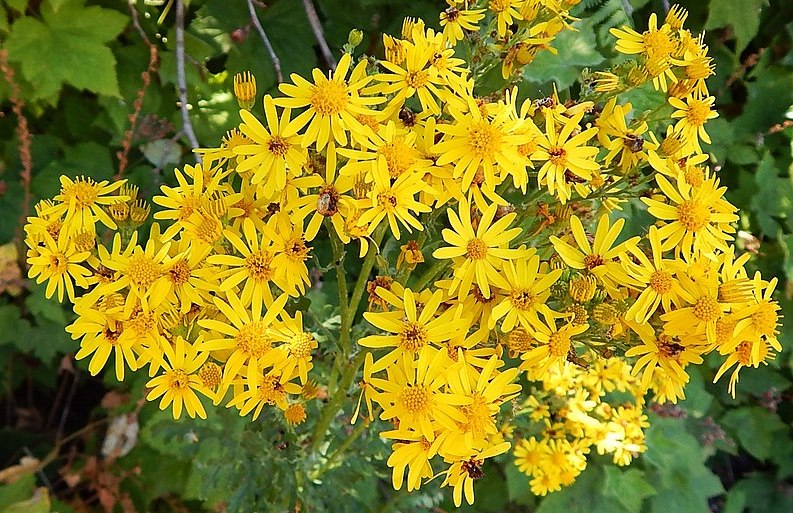
Tansy ragwort. photo by Ron Clausen, Creative Commons. License at: Creative Commons — Attribution-ShareAlike 4.0 International — CC BY-SA 4.0
Back at Mima Mounds, Wilderman says that the tansy ragwort is allowed to stay, for now, carefully segregated from the Preserve’s neighbors. With its help, he hopes valley silverspots and Puget Sound fritillaries will be waiting as the prairie’s native plants recover.
Puget Sound fritillary | Washington Department of Fish & Wildlife
Valley silverspot | Washington Department of Fish & Wildlife
The Mima Mounds Natural Area Preserve is located in Thurston County, south of Olympia, Washington. It includes a ½-mile ADA-accessible paved loop, with additional gravel trails to the north and south. Parking requires a Washington state Discover Pass.
 Mima Mounds Natural Area Preserve
Mima Mounds Natural Area Preserve
The nearby Glacial Heritage Preserve is open to the public only on Prairie Appreciation Day, the second Saturday in May.
 Prairie Appreciation Day
Prairie Appreciation Day
Most intact Puget Sound prairies are in the South Sound, but the Pacific Rim Institute is in the process of restoring their 175-acre preserve on central Whidbey Island.
 Pacific Rim Institute prairie restoration project
Pacific Rim Institute prairie restoration project
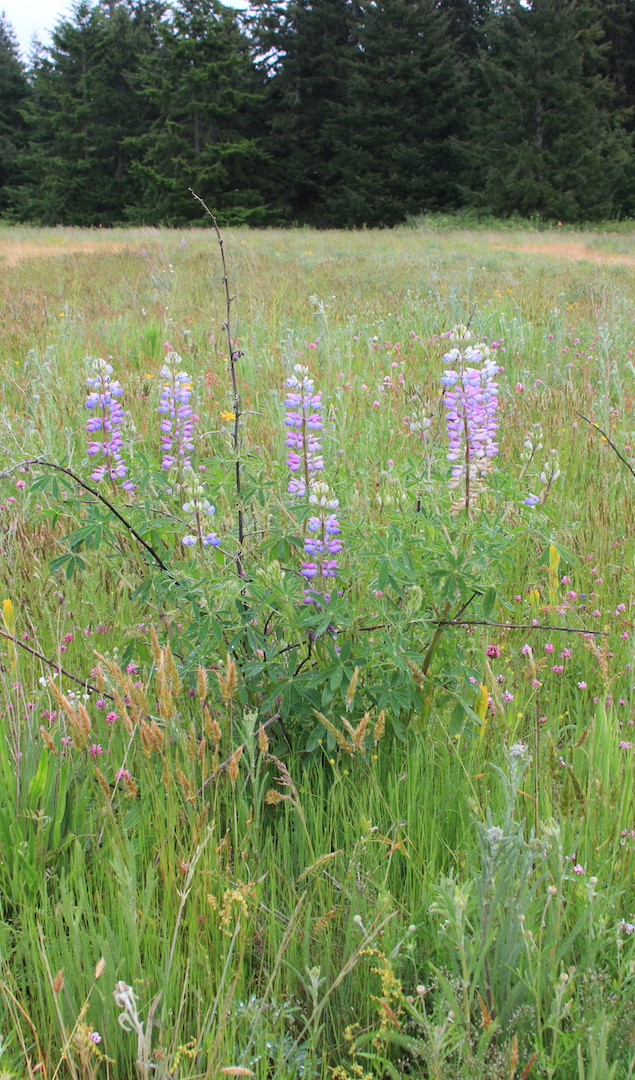
Whidbey Island prairie with lupine blooming in spring. photo by Thomas Noland

Katherine Derbyshire is a Seattle area freelance writer focused on science and technology. Follow her climate coverage on Twitter @carbon_to.
Table of Contents, Issue #17, Autumn 2022
Mountain Lilies
By Laura Mariko Marx, Autumn 2022The white avalanche lily (Erythronium montanum) and the yellow glacier lily (Erythronium grandiflorum) are native Pacific Northwest flowers that are related, but are usually found at slightly different altitudes. The best time to see...
All Kinds of Flowers!
By Fayla Schwartz, Autumn 2022 photos by Fayla Schwartz except as notedphoto by Thomas NolandBy Fayla Schwartz, Autumn 2022 photos by Fayla Schwartz except as notedThe Salish Sea region is home to a wide variety of flowering plants. This article provides a short...
Dandelion Transformation
by John F. Williams, Autumn 2022 by John F. Williams, Autumn 2022A rugged-looking brown seed attached to a parachute glides through the air. How did that dandelion flower create dozens and dozens of these seeds? This six minute video takes a look at that...
Poetry-17
Autumn 2022 Autumn 2022All Goes Round Poem and photos by Barb Erickson Roundis the sun,seeming to rise each dayand descend each night,providing heat and light and morethan a touch of mysteryIt is roundwe are toldbut we dare not stare it in the faceto see for...
Sidewalk Wilderness
Text & photos by Sara and Thomas Noland, Autumn 2022 Queen Anne's lace.Text & photos by Sara and Thomas Noland, Autumn 2022The sidewalk is not the first place that comes to mind when thinking about habitat for plants and animals. Even discussions of “urban...
The Dandy Dandelion
By Sarah Lorse, Autumn 2022 photos by John F. Williams except as noted By Sarah Lorse, Autumn 2022 photos by John F. Williams except as notedThe dandelion is an iconic flower. It brings a burst of cheery yellow in early spring and summer seed-poofs to wish upon — a...
Native Flowering Shrubs
By Julie O'Donald, Autumn 2022Flowering salal. photo by John F. WilliamsBy Julie O'Donald, Autumn 2022When it comes to wildflowers, native shrubs aren't the first thing most people think of, yet nature's gardens include an abundance of flowering shrubs at the right...
PLEASE HELP SUPPORT
SALISH MAGAZINE
DONATE
Salish Magazine contains no advertising and is free. Your donation is one big way you can help us inspire people with stories about things that they can see outdoors in our Salish Sea region.
We also don't advertise Salish Magazine, so please spread the word of this online resource to your friends and colleagues.
Thanks so much for your interest and your support.
We also don't advertise Salish Magazine, so please spread the word of this online resource to your friends and colleagues.
Thanks so much for your interest and your support.

